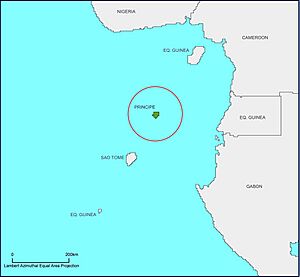Palm forest tree frog facts for kids
Quick facts for kids Palm forest tree frog |
|
|---|---|
| Conservation status | |
| Scientific classification | |
 |
|
| range | |
| Synonyms | |
|
Hylambates palmatus Peters, 1868 |
The palm forest tree frog (Leptopelis palmatus) is a special kind of frog. It belongs to the family Arthroleptidae. This frog lives only on Príncipe island, which is part of the country São Tomé and Príncipe. When an animal or plant lives only in one place, it's called endemic. For a long time, another frog called the red tree frog (Leptopelis rufus) was thought to be the same species. But now, scientists know they are different.
What Does the Palm Forest Tree Frog Look Like?
The palm forest tree frog is a large frog. Female frogs can grow to be about 81 to 110 millimeters long. This measurement is taken from their snout (nose) to their vent (bottom). They have a big eardrum, called a tympanum. Their feet are fully webbed, which helps them swim.
The frog's color can be different for each one. But usually, its back, called the dorsum, is dark green to black. Sometimes, it has many light spots. This makes the frog look like it has a marbled pattern. The frog's belly, called the ventrum, is dark and feels bumpy.
Compared to the red tree frog, the palm forest tree frog has some differences. It has larger openings where its nose passages meet its throat. These are called choanae. It also has bigger eardrums and a different skin texture.
Where Does This Frog Live and How Is It Protected?
The palm forest tree frog lives in wet forests. You can find them near creeks and streams. They live at heights up to 700 meters above sea level. They might even live as high as 1000 meters. These frogs can also be found in small parts of forests that are left. Sometimes, they might even live in towns.
Scientists believe that these frogs bury their eggs close to water. When the eggs hatch, the baby frogs, called tadpoles, move into pools or streams. There, they grow and change into adult frogs.
This frog is quite common across Príncipe island. However, its home is at risk. People are building more things, which means the frog's habitat (where it lives) is getting smaller. This is a possible threat for the future.
The palm forest tree frog does not live in any special protected areas. The International Union for Conservation of Nature (IUCN) is a group that checks on animals around the world. They have said that this frog is "endangered." This means it is at a high risk of becoming extinct. Because of this, the frog's population needs to be watched carefully.


